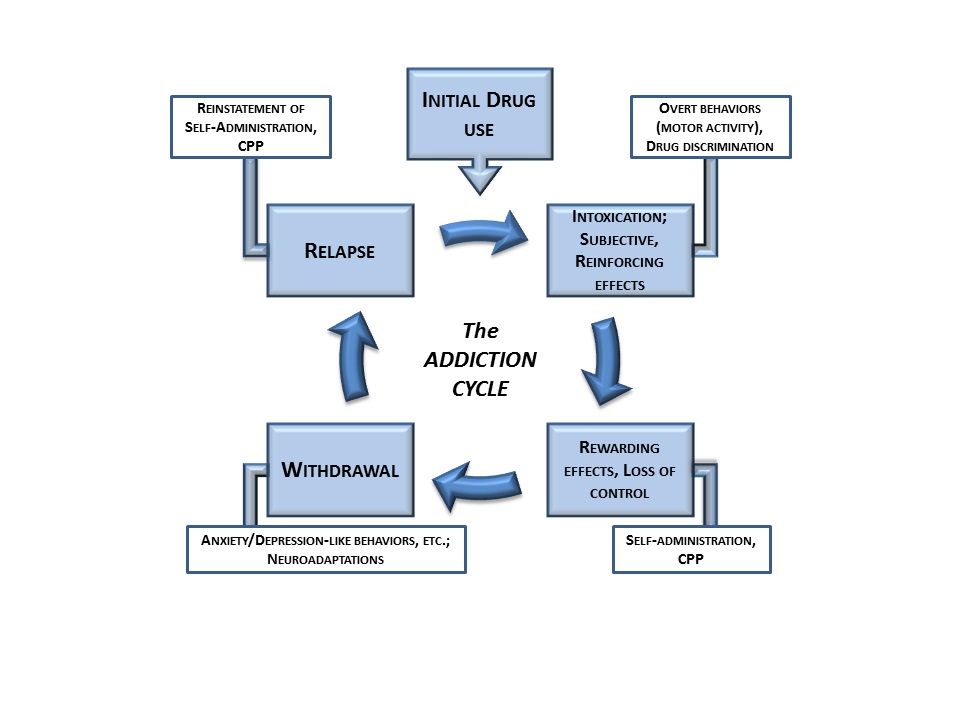Fattore Liana
 Senior research scientist
Senior research scientist
Cittadella Universitaria di Monserrato
S.S. 554, Km 4,5
09042 Monserrato (CA)
Tel 070-6754337
Fax 070-6754320
Questo indirizzo email è protetto dagli spambots. È necessario abilitare JavaScript per vederlo.
Behavioural neuropharmacology
Research summary
The main research line in the laboratory of Behavioural Neuropharmacology concerns the study of the neurobiological mechanisms underlying drug addiction (mostly cannabinoids and nicotine) in rodents (mice and rats) and, more in general, of compulsive and addictive behaviours (e.g. binge eating) (Fig. 1).

Figure 1. Addictive behaviours affecting cortical and limbic brain systems
We routinely use animal models of drug addiction and dependence and perform behavioral test to understand how drugs of abuse, including the most recent novel psychoactive substances (NPS), may impact on brain functioning and alter emotional states and behavioral responses. All phases of the drug addiction cycles are investigated, from the initial occasional use to relapse after drug abstinence

Figure 2. Most common animal models and behavioral test used to study the different aspects of the addiction cycle.
Our research includes the study of the potential risk factors that may enhance vulnerability to addiction, like age and animal strains but also levels of steroid hormones and psychiatric comorbidity (depression). Particular attention is given to sex-dependent differences in cannabinoid abuse and dependence (Fig. 3).

Figure 3. Gender- and sex-dependent differences in cannabinoid addiction
Lab Team
Paola Fadda
Maria Scherma
Mary Tresa Zanda
Silvia Antinori
Representative publications
Mutti A, Aroni S, Fadda P, Padovani L, Mancini L, Collu R, Muntoni AL, Fattore L, Chiamulera C. (2016). The ketamine-like compound methoxetamine substitutes for ketamine in the self-administration paradigm and enhances mesolimbic dopaminergic transmission. Phsychopharmacology 2016 Mar 28.
Fattore L (2016). Synthetic Cannabinoids-Further Evidence Supporting the Relationship Between Cannabinoids and Psychosis. Biol Psychiatry 79:539-48.
Devoto P*, Fattore L*, Antinori S, Saba P, Frau R, Fratta W, Gessa GL (2016) Elevated dopamine in the medial prefrontal cortex suppresses cocaine seeking via D1 receptor overstimulation. Addict Biol 21, 61-71. *equal contribution
Fattore L, Melis M, Fadda P, Fratta W (2014). Sex differences in addictive disorders. Front Neuroendocrinology 35, 272-84.
Morel C*, Fattore L*, Pons S, Hay YA, Marti F, Lambolez B, De Biasi M, Lathrop M, Fratta W, Maskos U, Faure P (2014). Nicotine consumption is regulated by a human polymorphism in dopamine neurons. Mol Psychiatry 19, 930-6. *equal contribution.
Melis M, Scheggi S, Carta G, Madeddu C, Lecca S, Luchicchi A, Cadeddu F, Frau R, Fattore L et al (2013). PPARα regulates cholinergic-driven activity of midbrain dopamine neurons via a novel mechanism involving α7 nicotinic acetylcholine receptors. J Neurosci 33, 6203-11.
Davis C, Fattore L, Kaplan AS, Carter JC, Levitan RD, Kennedy JL (2012) The suppression of appetite and food consumption by methylphenidate: the moderating effects of gender and weight status in healthy adults. Int J Neuropsychopharmacol 15, 181-7.











